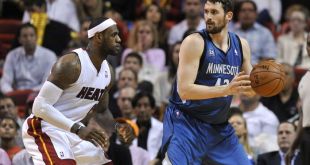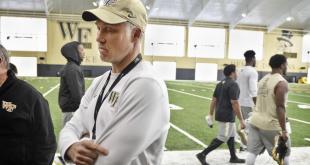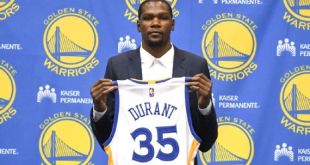Tweet
Recent media reports have suggested that in addition to ongoing trade talks with Minnesota for superstar power forward Kevin Love, Cleveland has only recently made #1 overall draft pick and fashion trailblazer Andrew Wiggins available in such trade talks. So let’s forget about ‘would they,’ ‘should they’ make this trade and focus on ‘could they?’ Let’s assume the trade is going down, and lets assume it does include Andrew Wiggins (a trade which would vastly alter the landscape of the NBA).[i] This article will break down the CBA rules regarding trades and salaries, and give a couple possible pictures of what such a trade could look like under the CBA rules.
Jennifer Pottheiser/NBAE via Getty Images.
The first step in any such analysis is to assess where both teams sit in relation to the salary cap and the luxury tax. Teams that would be under the salary cap post trade, can do whatever they want trade wise, however teams over the cap need to send out approximately the same amount of salary which they bring in. Both the Minnesota Timberwolves ($9,428,980 over the salary cap and $3,640,020 under the luxury tax) and the Cleveland Cavaliers ($4,435,456 over the salary cap and $8,144,010 under the luxury tax) are over the salary cap which means that depending on how much over the cap (or the tax) they are post trade, there are different rules which may be triggered depending on the particular trade. The NBA always considers team salaries post trade in determining which rules to apply.
Assuming any potential trade would not put either team into the luxury tax (while there is a small chance Minnesota could end up in the tax after a trade, none of the likely scenarios below would trigger such a situation) the rule will depend on whether or not Kevin Martin is included in the trade. If Kevin Martin is not in the trade, the incoming salary for each team must not be greater than the outgoing salary plus five million dollars.[ii] If Kevin Martin is in the trade, the incoming salary for each team must not be greater than 125% of the outgoing salary plus $100,000.[iii] Let’s put it simply: If Kevin Martin is not in the deal, the salaries must match within five million dollars. If Martin is included the salaries must match within 125% plus $100,000. Simple enough?
Another rule to consider is that per the CBA rookies who sign contracts may not be traded within 30 days of signing the contract. As of now Wiggins has not signed. This matters because Wiggins salary is going to be 120% of his rookie scale or about 5.3-5.4 million dollars. If he is traded before signing, he has no salary (as the Cavs are simply trading his draft rights).
A couple other things to note before we take a look at some possibilities. One is that in terms of draft picks available for Cleveland to sweeten the deal with, there isn’t much there. Cleveland has all its own picks plus one from Miami, but since both teams are likely playoff teams (especially in the East) those really aren’t worth too much.
Scenario 1. Wiggins Has Not Signed Yet; Kevin Martin Not Included
Kevin Love has a salary of about $15,000,000 so both teams must comply with the rule “outgoing salary plus five million” as long as Minnesota is taking back closer to $15,000,000 than $20,000,000. Below are some possible trades under this scenario
Cleveland Receives: Kevin Love ($15,719,063)
Minnesota Receives: Anderson Varejao ($9,704,545), Rights to Andrew Wiggins ($0) and one of Anthony Bennett ($5,563,920) or Tristan Thompson ($5,138,430) or Dion Waiters ($4,062,000)
Cleveland could also throw in any number of draft picks to sweeten the pot however per above, they really wouldn’t move the needle much unless Miami implodes.
Scenario 2. Wiggins Has Not Signed yet; Kevin Martin Is Included
Since Martin’s Salary pushes the Minnesota package total salary above 19.6 million, the new rule to match is 125% plus $100,000. Below are some trade possibilities
Cleveland Receives: Kevin Love ($15,719,063) and Kevin Martin ($6,792,500)
Minnesota Receives: Anderson Varejao ($9,704,545), Rights to Andrew Wiggins ($0) and two of Anthony Bennett ($5,563,920) or Tristan Thompson ($5,183,430) or Dion Waiters ($4,062,000).
Under this scenario its much less likely that Cleveland would throw in any picks since it is doubly worse for them than scenario 1 (they have to lose an additional asset and take back a contract that would burden even the most resilient Ancient Mariner.[iv]
Scenario’s 1 and 2 are more beneficial for Minnesota who will be able to get an extra 4-6 million dollar asset out of Cleveland since Wiggins will not count for any salary. Minnesota would then use the Rookie exception to sign Wiggins to his rookie scale contract.
Scenario 3. Wiggins has Signed; Kevin Martin Not Included
This trade would have to take place at least 30 days after Wiggins signs his rookie contract. The salary rules would be the same as in Scenario 1.
Cleveland Receives: Kevin Love ($15,719,063)
Minnesota Receives: Anderson Varejao ($9,704,545), Andrew Wiggins (~$5,400,000)
Under this scenario Cleveland is not required to include Bennett, Thompson or Waiters. Which is a good thing for the Cavaliers as it leaves them with more assets that can help them win or be disposed of for draft picks and trade exceptions later.
Scenario 4. Wiggins has Signed; Kevin Martin Is Included
Salary rule wise we are now back in Scenario 2 and the deal must occur at least 30 days after Wiggins has signed.
Cleveland Receives: Kevin Love ($15,719,063) and Kevin Martin ($6,792,500)
Minnesota Receives: Anderson Varejao ($9,704,545), Andrew Wiggins (~$5,400,000) and one of Anthony Bennett ($5,563,920) or Tristan Thompson ($5,183,430) or Dion Waiters ($4,062,000).
As you can see Cleveland would prefer Scenario’s 3 or 4 while Minnesota would prefer 1 or 2. After the trade Cleveland would have to fill out the rest of its roster with minimum salaries and could use the Bi-Annual Exception which would allow a contract to start at 2.077 million. Cleveland already used its “room mid level” exception on Mike Miller. Regardless, this is a potential trade which would vastly alter the NBA landscape. With that, I will adjourn and leave the EMBRACE DEBATE to Stephen A. and Skip to tell us all whether any of this is a good idea.
[i] https://www.youtube.com/watch?v=uvqJ1mTkEuY [ii] This is the rule for teams over the cap but under the tax where the outgoing salary is between $9,800,000 and $19,600,000. Love Makes $15,719,063 and Cleveland would be unlikely to send so much salary back to Minnesota so as to trigger another rule. [iii] This is the rule for teams over the cap but under the tax where the outgoing salary is over $19,600,000. Together, Love and Martin make over $22,000,000. [iv] Why is the Ancient Mariner burdened you ask? It’s an albatross of a contract. The phrase “albatross around your neck” referring to a heavy burden impeding success was originally coined in English Poet Samuel Taylor Coleridge’s poem “The Rime of the Ancient Mariner”.
 The Sports Esquires Putting Sports on Trial
The Sports Esquires Putting Sports on Trial





I would hate to see this trade go down. I was excited to see LeBron go from this aging team that manufactured a team by colluding with other stars, to seeing young talent grow with a player like LeBron. I would hate on Cleveland again if they made this trade. They wouldn’t be any better than the Yankees, Heat, etc. The Spurs have shown how you build a dynasty, and Miami has shown exactly what you need to do to be on top for a few years, and then go back to mediocrity. Organizations should strive to be the Spurs, not the Heat.
I agree and I would argue that from a cap perspective, it can be smarter for a team to have two max players and then have 15-25 million in cap space to spend on other useful players instead of three max players and whatever they can find via minimum salaries, the mid level and biannual exceptions. I would think Cleveland is arguably better with Wiggins/Waiters/Thompson/Bennett than with Love and 4 min salary guys. Even if they don’t have to give up all four of those pieces in a trade, unless Cleveland is willing to go waaay over the Tax, some will eventually be cap casualties.